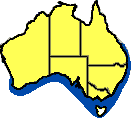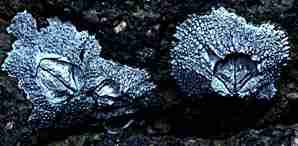|
|

Rosette Barnacle, Tetraclitella purpurascens
Form:
Barnacle with a low, wide shell made up of four wall plates, with a distinctive, rough, scaly appearance.
In uneroded specimens, where the shell plates are distinct, the orifice is diamond shaped. The inside of the plates is finely porous, forming a honeycomb pattern.
Colour:
Exterior grey-white, with a mauve or greenish tinge.
Phylum: |
Arthropoda |
Author: |
Wood, 1815 |
Family: |
Tetraclitidae |
Size: |
20-25 mm diameter |
Distribution:
 Occurs
from Queensland, south around southern Australian shores to Western Australia.
Occurs
from Queensland, south around southern Australian shores to Western Australia.
Habitat:
Found at any level on rocky ocean shores, up to high water neap. Always found in protected and semi-protected situations. It prefers crevices, or shelters under boulders, or sloping rocks where there is shade. It is sensitive to being dried out by the sun.
References:
Bennett, I. (1987) W.J. Dakin's classic study: Australian Seashores. p.246, Angus & Robertson, Sydney.
Davey, K. (1998) A Photographic Guide to Seashore Life of Australia. p.43, New Holland, Sydney.
Edgar, G.J. (1997) Australian Marine Life: the plants and animals of temperate waters. p.173, Reed Books, Kew.
Jones, D, & Morgan, G. (1994) A Field Guide to Crustaceans of Australian Waters. p.34, Reed.
Quinn, G.P., Wescott, G.C. & Synnot, R.N. (1992) Life on the Rocky Shores of South-Eastern Australia: an illustrated field guide. p.64, Victorian National Parks Association, Melbourne.
Marine Research Group of Victoria (1984) Coastal Invertebrates of Victoria: an atlas of selected species. p.106, Museum of Victoria, Melbourne.
Underwood, A.J. & Chapman, M.G. (1993) Seashores: a beachcomber's guide. p.36, New South Wales University Press, Sydney.
Surf
Barnacle
Six-plated Barnacle
Honeycomb Barnacle
Rose-coloured Barnacle
Rosette Barnacle
Giant Rock Barnacle
Home
Page
Taxonomy
Biogeography
Rocky Shores
Tidal Levels
Intertidal Zonation
Environmental Factors
Biological
Factors
Feeding Relationships
Activities
Glossary
References
 Life
on Australian Seashores
Life
on Australian Seashores
by Keith Davey (C) 2000
Learning Consultant
- Media
The University of Newcastle
email at australian_seashores@hotmail.com
Scientific Consultant: Phil
Colman
site created 01.01.98 : updated 01.04.2000
